A GUIDE TO THE OPERA







September 11, 2024
Dear Opera Curious and Opera Lovers alike,
Boston Lyric Opera is pleased to welcome you to the Emerson Cutler Majestic Theatre as we present Wolfgang Amadeus Mozart’s opera Mitridate, re di Ponto
Opera is an art form that can contain big emotions. The experience of seeing and hearing live, professional opera is one of a kind, and we encourage you to explore the world of the opera outside the theater as well. We are proud to offer this Guide to support your engagement with this opera. Please note that this Guide describes plot details. Our intent is to provide support in historical as well as contemporary context, along with tools to thoughtfully reflect on the opera before or after you attend.
Boston Lyric Opera inspires, entertains, and connects communities through compelling performances, programs, and gatherings. Our vision is to create operatic moments that enrich everyday life. As we continue to develop additional Guides, we want your feedback. Please tell us about how you use this guide and how it can best serve your learning and engagement needs by emailing education@blo.org
If you’re interested in engaging with us further and learning about additional opera education opportunities with Boston Lyric Opera, please visit blo.org/ education to discover our programs and initiatives.
See you at the opera!
Sincerely,
Boston Lyric Opera’s Public Engagement Team
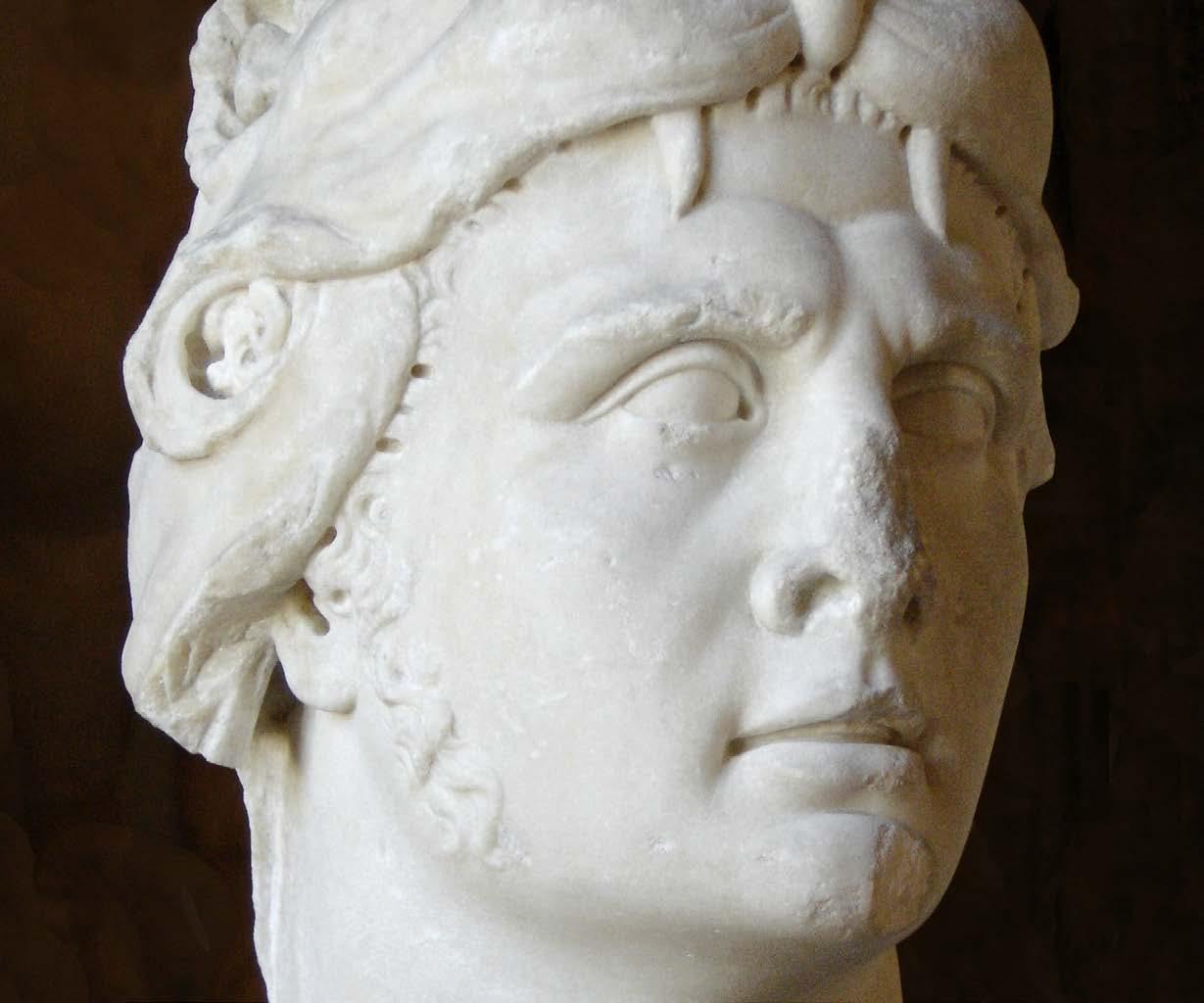
Mitridate, ruler of Pontus, has left his sons – Farnace and Sifare – in charge while he is away at war against the Romans. The two are political enemies: Farnace, the eldest, is sympathetic to the Romans; and Sifare, his half-brother, supports the Greeks. A rumor soon reaches them that Mitridate has been killed in action. Arbate, the governor of Ninfea, promises to support Sifare if Farnace tries to grab power. Farnace, who has been engaged to Ismene, begins to pursue Aspasia, his father’s betrothed, instead. In fact, both Farnace and Sifare are in love with Aspasia – but she only has feelings for Sifare. Aspasia rejects Farnace and, seeking to defend herself from his advances, confides in Sifare, who promises to protect her. Spurred by his thwarted ambitions, Farnace begins to conspire with Marzio, the Roman tribune.
Arbate announces Mitridate’s return – he has not been killed, only defeated in battle by Pompey, the Roman leader. It is later revealed that Mitridate told Arbate to spread a false rumor of his death so he could test the loyalty of his sons, who remain unaware of this. Farnace considers opposing his father openly; Sifare refuses to help, but Marzio backs Farnace. Mitridate has brought Ismene back with him and urges Farnace to wed her, as their marriage would create a strong political alliance. He is also suspicious of Farnace’s intentions toward Aspasia. Arbate assures Mitridate of Sifare’s loyalty, but reveals Farnace’s treachery. Mitridate vows revenge on his firstborn son.
In the royal apartments, Farnace tells Ismene that he does not love her anymore. She reports this to Mitridate, stoking his vengeful intentions toward Farnace. Anticipating his next return to the battlefield, Mitridate proposes to Aspasia, but she is reluctant, and he mistakenly believes that she
loves Farnace. He tells his sons that he plans to attack the Romans and watches their reactions closely. Farnace tries to dissuade his father from the plan, but Sifare declares that he will lead the army himself. Marzio shows up again, and his arrival convinces Mitridate of Farnace’s disloyalty. Farnace admits his betrayal, but also reveals Sifare’s love for Aspasia. Enraged, Mitridate arrests both of his sons, tricks Aspasia into confessing her love for Sifare, and condemns them all to death.
Ismene intervenes with Mitridate on Aspasia’s behalf. Mitridate tells Aspasia that he will forgive her infidelity and pardon Sifare if she promises herself to him. She refuses. Arbate alerts everyone to an attack by the Romans. As Mitridate prepares for battle, he has a goblet of poison sent to Aspasia, who decides to take it. However, Sifare – who has been freed by Ismene – talks her out of it, and goes to help his father defeat the Romans.
Meanwhile, Marzio frees Farnace from prison and promises to make him king. But a remorseful Farnace renounces his claim to the throne, his pursuit of Aspasia, and his alliance with the Romans – and sets fire to the Roman fleet that is anchored in the harbor. Mitridate is victorious, but reveals that he mortally wounded himself in order to avoid being captured by the enemy. As his strength fades, he forgives both of his sons, having witnessed their loyal defense of the kingdom. Sifare and Aspasia become engaged, as do Farnace and Ismene (again). Mitridate approves both betrothals and dies happy.
Mitridate (Mee-tree-DAH-teh) (tenor) – King of Pontus
Aspasia (Ah-SPA-zyah) (soprano) – Mitridate’s fiancee
Farnace (Far-NAH-cheh) (countertenor) – Mitridate’s eldest son
Sifare (See-FAH-reh) (soprano) – Mitridate’s son
Ismene (Eez-MEH-neh) (soprano) – daughter of the Parthian King
Marzio (MAR-tsyoh) (tenor) – a Roman official
Arbate (Ar-BAH-teh) (mezzo-soprano) – Governor of Nymphæa
Like many modern opera companies, Boston Lyric Opera often reimagines existing operas. This means that things like setting, time period, and some story choices may be different from the original. In our production of Mitridate, we’ve moved away from the plot point of war, Mitridate and his family are not literal royalty, and the story is set in the 1950s, which you’ll see reflected in the set and costume designs.


Wolfgang Amadeus Mozart was born in January of 1756 in Salzburg, Austria.
He was the youngest of seven children; yet only he and his older sister, Nannerl, survived into adulthood. Their father, Leopold, was a music teacher and began to teach his daughter music when she turned seven. Even before he reached the age of three, Wolfgang observed his sister’s lessons, copying what he heard later at the family’s clavier — an instrument that was a predecessor to the pianoforte. It was then that Leopold noticed his son’s impressive aptitude for music and began giving him lessons, too. A year or so later, Mozart composed his first short pieces, which his father transcribed. When Mozart was six, he went on tour with his sister and father across Europe, performing for courts and noblemen. The Mozart children were widely regarded as prodigies. The tour lasted over five years, traversing England, France, Germany, Austria, the Netherlands, Switzerland, and Bohemia (the region that later became the Czech Republic). This tour exposed Wolfgang to a variety of European musical styles and traditions at a very early age, which would influence his later compositions.
Wolfgang had a keen ability to hear other composers’ music, imitate those sounds, and weave their styles

When Mozart was only six years old, he met the sixyear-old archduchess Marie Antoinette (the future queen of France) while playing for the Vienna court with his family. It is said that Mozart slipped on the floor, Marie Antoinette helped him up, and he, in turn, proposed to her! Mozart was known as an affectionate, spirited, and charming child. It is also said that in that same visit, Wolfgang climbed into the lap of Marie Antoinette’s mother, Maria Theresa, the Holy Roman Empress and Queen of Hungary, and kissed her.

into his own work. While in Vienna, Mozart attended the premiere of Gluck’s opera Orfeo ed Euridice, and Haydn’s Symphonies 6, 7, and 8 at the Esterházy Palace. Mozart also attended concerts featuring the music of Florian Leopold Gassmann and Johann Baptist Wanhal - two composers who were integral to the German Sturm und Drang (storm and stress) movement. He met Johann Christian Bach, the son of Johann Sebastian Bach, while the Mozart family was in London. If you listen to compositions from Mozart’s early years, you’ll find that he imitated and borrowed from the works of his contemporaries.
Wolfgang wrote his first symphony at the age of eight while on tour. Following the tour, his family remained home for a year, and during that time, Wolfgang composed and premiered his first four operas, along with numerous other pieces. He experimented with different operatic styles, his first opera resembling a sacred musical play for the church, his second a

Greek myth in Latin, his third a one-act Austrian comedy, and his fourth in the Italian opera buffa style.
Leopold and Wolfgang set off again in December of 1769 for another tour. Wolfgang was just 13. The pair traversed Italy for two years and, during their stay in Milan in 1770, Mozart composed and premiered Mitridate, re di Ponto, his fifth opera, but his first opera seria and his second opera in Italian. This opera was a success and led to additional commissions.
At the age of 17, Mozart was appointed as a court musician in his hometown by Prince-Archbishop Hieronymus von Colloredo of Salzburg. After a few years, he tired of the work, as it was not challenging and did not pay well. He quit and went in search of a better paying job that lent him more artistic freedom. His job search took him across Europe, including to
It’s very common for musicians of all genres to be inspired by and/or borrow from one another. In today’s popular music, Sampling, where a direct quote from another’s music is featured in one’s composition, is an example of this. It not only pays respect to that musician, but also helps the listener to make meaning of the music, fitting it within a lineage of cultural context.
Germany and France, with little success. He was soon very short on funds and becoming increasingly desperate. While he was in Paris, his mother passed away, and he stayed a while to mourn his mother’s death and rest from his search. All the while, he continued to compose. Eventually, he settled in Vienna, where he was able to build a freelance lifestyle, receiving commissions — largely from the emperor — and self-producing much of his work.
When Wolfgang was 26, he met and married Constanze Weber, a singer, and together the couple had six children, with only two surviving infancy. As Wolfgang’s fame grew, so too did his lavish lifestyle, which included leasing a very expensive apartment and purchasing a fortepiano.
In 1786, Wolfgang shifted his focus more seriously to operas and, in the five years that would follow, dedicated himself to composing and premiering seven operas, including his most famous ones: Le nozze di Figaro, Don Giovanni, Così fan tutte, and Die Zauberflöte, as well as many of his most beloved symphonies, concertos, and quintets. Even in this period of great creative productivity, he continued to live outside his means and was soon carrying
large debts and tremendous stresses because of them. In his later years, Mozart would find a few new arts patrons, easing his financial troubles.
Mozart fell ill in the fall of 1791 and died at the end of that year. He was only 35 years old. In those three and a half decades of life, Wolfgang wrote nearly 500 compositions including 60 symphonies, over 50 concertos, over 30 Masses and pieces of sacred music, and 23 operas. He left a requiem unfinished. Today, Mozart is the second most performed opera composer in the world.
What would it be like to have a talent for which you toured the world starting at age six? Can you think of any contemporary examples?


in Pergamon. Dated month 12, year 223 BE (September 74 BCE). Classical Numismatic Group, Inc. Creative Commons.
Mithridates cultivated immunity to poisons by regularly ingesting non-lethal doses of poison, a practice that is now known today as “mithridatism”.
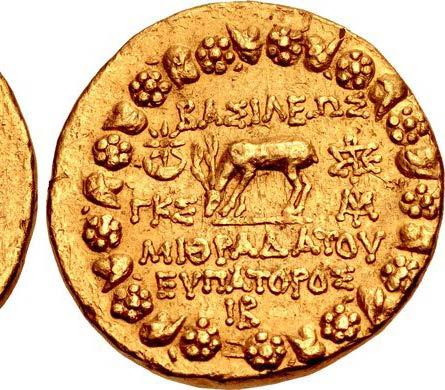


Mithridates VI was the King of Pontus between 120-63 BCE. Pontus was a region of the Greek Empire along the Black Sea in what is modern-day Turkey. Mithridates VI is regarded as a strong ruler, having won many battles against the Romans, defending and expanding his kingdom substantially during his reign. He was of both Iranian and Greek ancestry and his name is derived from that of the ancient Iranian sun god, Mithra.
When Mithridates VI was just a boy, his father, Mithridates V, was poisoned. The king’s sons were not old enough to take over, so his mother reigned as regent. She favored Mithridates VI’s brother to take the throne and plotted to ensure his ascension by any means necessary, so Mithridates VI went into hiding. He emerged years later once he’d come of age
and took the throne from his brother and mother, imprisoning them both. He married his youngest sister to preserve the purity of his bloodline. He then embarked on a series of wars to expand his kingdom. These wars lasted decades and are known as the Mithridatic Wars. They involved not only battles, but also strategic marriages to secure alliances.
Mithridates VI had six wives, several mistresses and concubines, and fathered over two dozen children. After one of his sons rebelled and joined his adversaries, defeating him in battle, Mithridates poisoned his wives and daughters and then committed suicide.
Mithridates VI’s life is immortalized in two operas, as well as several poems, songs, and novels.

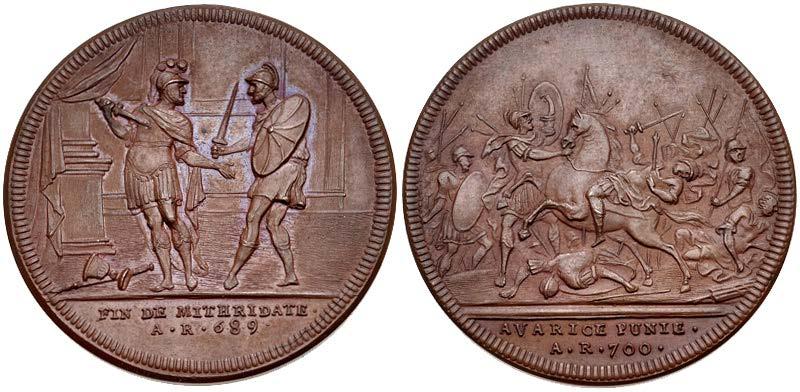

Mitridate, re di Ponto marks Mozart’s first full-length opera seria – or “serious opera” – composed when he was just fourteen years old.
Opera seria (“serous opera”) was the predominant style of opera in 1700s Europe. Its primary emphasis was on the solo voice and the bel canto (Italian for “beautiful singing”) style, and its plots often revolved around myths and heroes. Opera seria stood in contrast to another popular style of opera – opera buffa – which were comedic and often contemporary in setting.
In early 1770, a young Mozart traveled to Milan, Italy with his father for their first Italian tour. There, he met Count von Firmian, who commissioned him to write an opera based on a play by Jean Racine titled “Mithridate” – a tragedy about the life of the ancient Mithridates, King of Pontus from 120 to 63 BCE.
Mozart was not the first to set Cigna-Santi’s libretto to music. Three years prior, it was the basis of Quirino Gasparini’s opera also titled Mitridate, re di Ponto, and some accounts claim that Gasparini pleaded with Antonia Bernasconi, the soprano singing the role of Aspasia, to sing his version of her character’s arias rather than Mozart’s at the Milanese premiere. Bernasconi rejected his request.
For this commission, Mozart was charged with setting poet-turned-librettist Vittorio Amedeo Cigna-Santi’s libretto (the poetic words) to music. Cigna-Santi’s libretto was clearly drawn from Racine’s play, but he did take some liberties.
Mozart’s Mitridate, re di Ponto premiered December 26, 1770 at Milan’s Teatro Regio Ducale. The production opened Milan’s season and featured many of the city’s biggest stars. The premiere was met with acclaim, and it is said that audiences cried, “Evviva il maestro!” (“long live the composer”) following performances. The production ran for a total of 21 shows before it closed. The Gazzetta di Milano newspaper praised Mozart for his studies of “the beauties of [human] nature and representing them adorned with the rarest music graces.” The success of Mitridate, re di Ponto established Mozart as a competent and gifted composer of opera seria, and led to the commission of Mozart’s next opera, Lucio Silla.
Following its 18th-century run, Mitridate, re di Ponto was not performed again until just over two hundred years later in 1971. The first to remount this opera was the Salzburg Festival in Mozart’s home country of Austria. Today, it is performed all over the world.
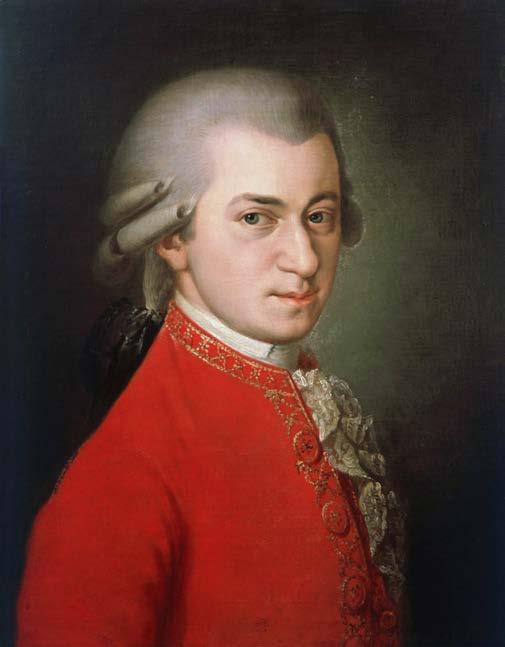
1 An overture is an orchestral piece that comes at the beginning of an opera and sets the tone for the piece. Listen to the overture to Mitridate, re di Ponto: https://youtu.be/LUElAhx15ms?si=j92S2XQcJK2AwEAg
From listening to the overture, what guesses do you have about the opera’s plot?
What can you guess about the setting and characters?
2
“Vado incontro al fato estremo” (“I’m going to meet the ultimate fate”) is an aria performed by the title character, Mitridate, in the opera’s final act. Listen to the aria.
Michael Spyres sings Mozart: Mitridate, re di Ponto, K. 87, Act III: “Vado incontro al fato estremo” (youtube.com)
From listening to this aria, what emotions do you think the character is experiencing? What about Mozart’s music makes you think this?
This aria is often referred to as Mitridate’s “rage aria” and comes in Act III as he leaves for battle in the wake of an argument with his son and fiancée. Can you hear this in the music, or does this come as a surprise?
• What instruments do you hear?
• How fast is the music? Are there sudden changes in speed? Is the rhythm steady or unsteady?
• Key/Mode: Is it major or minor? (Does it sound bright, happy, sad, urgent, dangerous?)
• Dynamics/Volume: Is the music loud or soft? Are there sudden changes in volume (either in the voice or orchestra)?
• What is the shape of the melodic line? Does the voice move smoothly, or does it make frequent or erratic jumps? Do the vocal lines move noticeably downward or upward?
• Does the type of voice singing (baritone, soprano, tenor, mezzo, etc.) have an effect on you as a listener?
• Do the melodies end as you would expect, or do they surprise you?
• How does the music make you feel? What effect do the factors above have on you as a listener?
• What is the orchestra doing in contrast to the voice? How do the two interact?
• What kinds of images, settings, or emotions come to mind? Does it remind you of anything you have experienced in your own life?
• Do particularly emphatic notes (low, high, held, etc.) correspond to dramatic moments?
• What type of character (romantic, comic, serious, etc.) fits this music?
EMR2015. 2021. “Mozart: Mitridate, Re Di Ponto.” Early Music Review. November 12, 2021. https://earlymusicreview.com/mozart-mitridate-re-di-ponto/.
Fuller, Nicholas. 2019. “146. Mitridate, Re Di Ponto (Mozart).” The Opera Scribe. August 9, 2019. https://operascribe.com/2019/08/09/146-mitridate-re-di-ponto-mozart/
Ross, Ailsa. 2018. “13 Facts about Wolfgang Amadeus Mozart.” Mentalfloss.com. July 2, 2018. https://www.mentalfloss.com/article/547532/facts-about-wolfgang-amadeus-mozart.
Smith, Sam. 2017a. “Mitridate, Re Di Ponto (Work - Wolfgang Amadeus Mozart/Amedeo CignaSanti).” Opera Online. July 1, 2017. https://www.opera-online.com/en/items/works/mitridate-re-diponto-cigna-santi-mozart-1770
2017b. “Mitridate, Re Di Ponto at the Royal Opera House, Covent Garden (Column).” Opera Online. July 1, 2017. https://www.opera-online.com/en/columns/samsmith/mitridate-re-diponto-at-the-royal-opera-house-covent-garden.
Timms, Elizabeth Jane. 2020. “When Mozart Met Marie Antoinette?” Royal Central. July 5, 2020. https://royalcentral.co.uk/features/when-mozart-met-marie-antoinette-133508/
“Vittorio Amadeo Cigna-Santi (Librettist).” n.d. StageAgent. Accessed July 18, 2024. https://stageagent.com/writers/1900/vittorio-amadeo-cigna-santi.
Glover, Jane. Mozart in Italy: Coming of Age in the Land of Opera. London: Picador, 2023.
Holden, Amanda. The New Penguin Opera Guide. London: Penguin, 2001.
Keefe, Simon P., ed. Mozart in Context. New York: Cambridge University Press, 2019.
Martin, Nicholas Ivor. The Opera Manual. Lanham: Scarecrow Press, 2014.
Mozart, Wolfgang Amadeus. Letters of Wolfgang Amadeus Mozart. Hans Mersmann, ed. M. M. Bozman, trans. New York: Dover Publications, 1972.
People have been telling stories through music for millennia throughout the world. Opera is an art form that is over 400 years old, with roots in Western Europe. Here is a brief timeline of its lineage.
Please note that all date ranges for these time periods are approximate, and notice that some even overlap.
1573 The Florentine Camerata was founded in Italy, devoted to reviving ancient Greek musical traditions, including sung drama.
1598 Jacopo Peri (1561-1633), a member of the Camerata, composed the world’s first opera –Dafne – reviving the classic myth.
1607 Claudio Monteverdi (1567-1643) wrote L’Orfeo, the first opera to become popular, marking him as the premier opera composer of his day and bridging the gap between Renaissance and Baroque music. His works are still performed today.
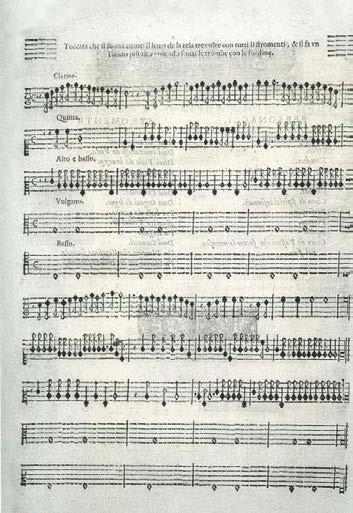
1637 The first public opera house, Teatro San Cassiano, was built in Venice, Italy.
1673 Jean-Baptiste Lully (1632-1687), an Italian-born composer, brought opera to the French court, creating a unique style, tragédie en musique, that better suited the French language. Blurring the lines between recitative and aria, he created fast-paced dramas to suit the tastes of French aristocrats.
1689 Henry Purcell’s (1659-1695) simple and elegant chamber opera, Dido and Aeneas, premiered at Josias Priest’s boarding school for girls in London.
1712 George Frederic Handel (1685-1759), a German-born composer, moved to London, where he found immense success writing intricate and highly ornamented Italian opera seria (serious opera). Ornamentation refers to stylized, fastmoving notes, usually improvised by the singer to make a musical line more interesting and to showcase their vocal talent.
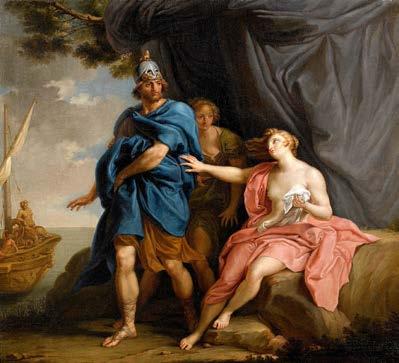
1805 Ludwig van Beethoven (1770-1827), although a prolific composer, wrote only one opera, Fidelio. The extremes of musical expression in Beethoven’s music pushed the boundaries in the late Classical period and inspired generations of Romantic composers.
1750s A reform movement, led by Christoph Willibald Gluck (1714-1787), rejected the flashy ornamented style of the Baroque in favor of simple, refined music to enhance the drama.
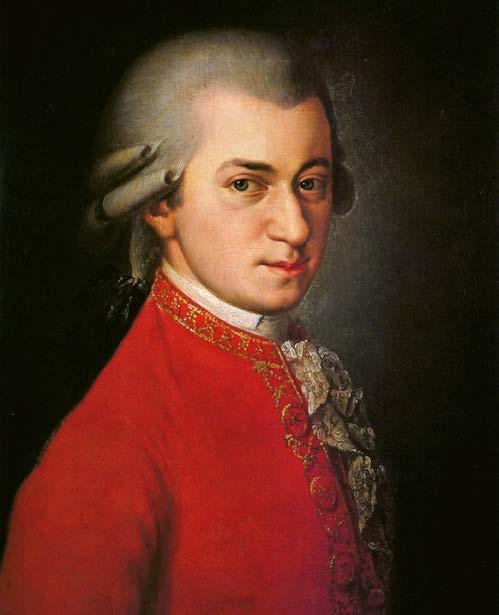

Wolfgang Amadeus Mozart (1756-1791) wrote his first opera at age 11, beginning his 25-year opera career. Mozart mastered and then innovated in several operatic forms. He wrote opera serias (serious operas), including La Clemenza di Tito, and opera buffas (comedic operas) like Le Nozze di Figaro (The Marriage of Figaro). He then combined the two genres in Don Giovanni, calling it dramma giocoso (comedic drama). Mozart also innovated the Singspiel, a German sung play featuring spoken dialogue, as in Die Zauberflöte (The Magic Flute).
Gioachino Rossini (1792-1868) composed Il barbiere di Siviglia (The Barber of Seville), becoming the most prodigious opera composer in Italy by age 24. He wrote 39 operas in 20 years. A new compositional style created by Rossini and his contemporaries, including Gaetano Donizetti and Vincenzo Bellini, would, a century later, be referred to as bel canto (beautiful singing). Bel canto compositions were inspired by the nuanced vocal capabilities of the human voice and its expressive potential. Composers employed strategic use of register, the push and pull of tempo (rubato), extremely smooth and connected phrases (legato), and vocal glides (portamento).
1853 Giuseppe Verdi (1813-1901) completed La Traviata, a story of love, loss, and the struggle of average people, in the increasingly popular realistic style of verismo. Verdi enjoyed immense acclaim during his lifetime, while expanding opera to include larger orchestras, extravagant sets and costumes, and more highly trained voices.
1842 Inspired by the risqué popular entertainment of French vaudeville, Hervé created the first operetta, a short comedic musical drama with spoken dialogue. Responding to popular trends, this new form stood in contrast to the increasingly serious and dramatic works at the grand Parisian opera house. Opéra comique as a genre was often not comic, tending to be more realistic or humanistic instead. Grand opera, on the contrary, was exaggerated and melodramatic.
1865 Richard Wagner’s (1813-1883) Tristan und Isolde was the beginning of musical modernism, pushing the use of traditional harmony to its extreme. His massively ambitious, lengthy operas, often based in German folklore, sought to synthesize music, theatre, poetry, and visuals in what he called a Gesamtkunstwerk (total work of art). The most famous of these was an epic four-opera drama, Der Ring des Nibelungen, which took him 26 years to write and was completed in 1874.

1871 Influenced by French operetta, English librettist W.S. Gilbert (1836-1911) and composer Arthur Sullivan (1842-1900) began their 25-year partnership, which produced 14 comic operettas, including The Pirates of Penzance and The Mikado. Their works inspired the genre of American musical theatre.
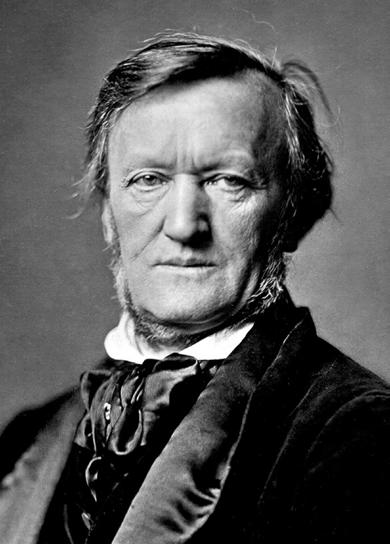

Johann Strauss II, (1825-1899) influenced largely by his father, with whom he shared a name and talent, composed Die Fledermaus, popularizing Viennese musical traditions, namely the waltz, and further shaping operetta
1896
Giacomo Puccini’s (1858-1924) La bohème captivated audiences with its intensely beautiful music, realism, and raw emotion. Puccini enjoyed huge acclaim during his lifetime for his works.
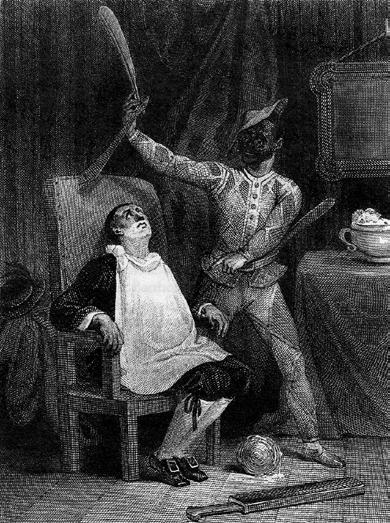

1911 Scott Joplin, (1868-1917) “The King of Ragtime,” wrote his only opera, Treemonisha, which was not performed until 1972. The work combined the European lateRomantic operatic style with African American folk songs, spirituals, and dances. The libretto, also by Joplin, was written at a time when when African Americans in the southern United States rarely had access to literacy resources and education.
1927 American musical theatre, commonly referred to as Broadway, was taken more seriously after Jerome Kern’s (1885-1945) Show Boat, with words by Oscar Hammerstein II (1895-1960), tackled issues of racial segregation and the ban on interracial marriage in Mississippi.
1922
Alban Berg (1885-1935) composed the first completely atonal opera, Wozzeck, dealing with uncomfortable themes of militarism and social exploitation. Wozzeck is in the style of 12-tone music, or serialism. This new compositional style, developed in Vienna by composer Arnold Schoenberg (1874-1951), placed equal importance on each of the 12 pitches in a chromatic scale (all half steps), removing the sense of the music being in a particular key.

British composer Benjamin Britten (1913-1976) gained international recognition with his opera Peter Grimes. Britten, along with Ralph Vaughan Williams (1872-1958), was one of the first British opera composers to gain fame in nearly 300 years.
American composer George Gershwin (1898-1937), who was influenced by African American music and culture, debuted his opera, Porgy and Bess, in Boston, MA with an allAfrican American cast of classically trained singers. His contemporary, William Grant Still (1895-1978), a master of European grand opera, fused that with the African American experience and mythology. His first opera, Blue Steel, premiered in 1934, one year before Porgy and Bess.


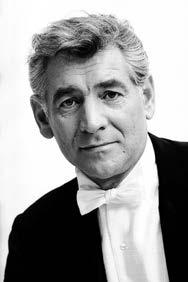
Leonard Bernstein (1918-1990), known for synthesizing musical genres, brought together the best of American musical theatre, opera, and ballet in West Side Story—a reimagining of Romeo and Juliet in a contemporary setting.
John Adams (b. 1947) composed one of the great minimalist operas, Nixon in China, the story of Nixon’s 1972 meeting with Chinese leader Mao Zedong. Musical minimalism strips music down to its essential elements, usually featuring a great deal of repetition with slight variations.

Anthony Davis (b. 1951) premiered his first of many operas, X, The Life and Time of Malcom X, which reclaims stories of Black historical figures within the theatre space. He incorporated both the orchestral and vocal techniques of jazz and classical European opera in his score for a distinctly American sound, and a fully realized vision of how jazz and opera are in conversation within a work.
Still a vibrant, evolving art form, opera attracts contemporary composers such as Philip Glass (b. 1937), Jake Heggie (b. 1961), Terence Blanchard (b. 1962), Ellen Reid (b. 1983), and many others. Composers continue to be influenced by present and historical musical forms in creating new operas that explore current issues or reimagine ancient tales.

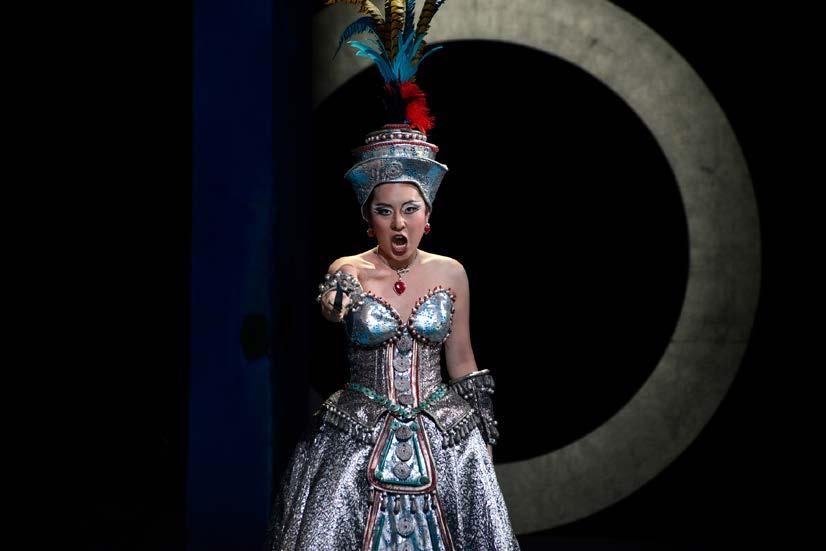
Opera is unique among forms of singing in that singers are trained to be able to sing without amplification, in large theaters, over an entire orchestra, and still be heard and understood! This is what sets the art form of opera apart from similar forms such as musical theatre. To become a professional opera singer, it takes years of intense physical training and constant practice — not unlike that of a ballet dancer — to stay in shape. Poor health, especially respiratory issues and even allergies, can be severely debilitating for a professional opera singer. Let’s peek into some of the science of this art form.
Singing requires different parts of the body to work together: the lungs, the vocal cords, the vocal tract, and the articulators (lips, teeth, and tongue). The lungs create a flow of air over the vocal cords, which vibrate. That vibration is amplified by the vocal tract and broken up into words by consonants, which are shaped by the articulators.
Any good singer will tell you that good breath support is essential to produce quality sound. Breath is like the gas that goes into your car. Without it, nothing runs. In order to sing long phrases of music with clarity and volume, opera singers access their full lung capacity by keeping their torso elongated and releasing the lower abdomen and diaphragm muscles, which allows air to enter into the lower lobes of the lungs. This is why we associate a certain posture with opera singers. In the past, many operas were staged with singers standing in one place to deliver an entire aria or scene, with minimal activity. Modern productions, however, often demand a much greater range of movement and agility onstage, requiring performers to be physically versatile, and bringing more visual interest, authenticity of expression, and nuanced acting into the storytelling.
If you run your fingers along your throat, you will feel a little lump just underneath your chin. That is your “Adam’s Apple,” and right behind it, housed in the larynx (voice-box), are your vocal cords. When air from the lungs crosses over the vocal cords it creates an area of low pressure (Google The Bernoulli Effect), which brings the cords together and makes them vibrate. This vibration produces a buzz. The vocal chords can be lengthened or shortened by muscles in the larynx, or by changing the speed of air flow. This change in the length and thickness of the vocal cords is what allows singers to create different pitches. Higher pitches require long, thin cords, while low pitches require short, thick ones. Professional singers take great pains to protect the delicate anatomy of their vocal cords with hydration and rest, as the tiniest scarring or inflammation can have noticeable effects on the quality of sound produced.
Without the resonating chambers in the head, the buzzing of the vocal cords would sound very unpleasant. The vocal tract, a term encompassing the mouth cavity, and the back of the throat, down to the larynx, shapes the buzzing of the vocal cords like a sculptor shapes clay. Shape your mouth in an ee vowel (as in eat), then sharply inhale a few times. The cool sensation you feel at the top and back of your mouth is your soft palate. The soft palate can raise or lower to change the shape of the vocal tract. Opera singers often sing with a raised soft palate, which allows for the greatest amplification of the sound produced by the vocal cords. Different vowel sounds are produced by raising or lowering the tongue, and changing the shape of the lips. Say the vowels: ee, eh, ah, oh, oo and notice how each vowel requires a slightly lower tongue placement and slightly rounder lips. This area of vocal training is particularly difficult because none of the anatomy is visible from the outside!
The lips, teeth, and tongue are all used to create consonant sounds, which separate words into syllables and make language intelligible. Consonants must be clear and audible for the singer to be understood. Because opera singers do not sing with amplification, their articulation must be particularly good. The challenge lies in producing crisp, rapid consonants without interrupting the connection of the vowels (through the controlled exhale of breath) within the musical phrase.
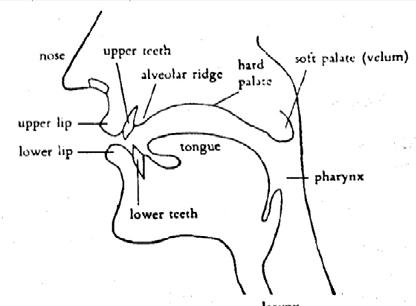
Perfecting every element of this complex singing system requires years of training and is essential for the demands of the art form. An opera singer must be capable of singing for hours at a time, over the powerful volume of an orchestra, in large opera houses, while acting and delivering an artistic interpretation of the music. It is complete and total engagement of mental, physical, and emotional control and expression. Therefore, think of opera singers as the Olympic athletes of the stage, sit back, and marvel at what the human body is capable of!
Opera singers are cast into roles based on their tessitura (the range of notes they can sing comfortably). There are many descriptors that accompany the basic voice types, but here are some of the most common ones:
The lowest voice, basses often fall into two main categories: basso buffo, which is a comic character who often sings in lower laughing-like tones, and basso profundo, which is as low as the human voice can sing! Doctor Bartolo is an example of a bass role in The Barber of Seville by Rossini.
A middle-range lower voice, baritones can range from sweet and mild in tone, to darker dramatic and full tones. A famous baritone role is Rigoletto in Verdi’s Rigoletto. Baritones who are most comfortable in a slightly lower range are known as Bass-Baritones, a hybrid of the two lowest voice types.
The highest of the lower-range voices, tenors often sing the role of the hero. One of the most famous tenor roles is Roméo Gounod’s Roméo et Juliette. Sometimes, singers with lower-range voices also cultivate much higher ranges, singing in range similar to a mezzo-soprano or soprano by using their falsetto register. Called the Countertenor, this voice type is often found in Baroque music. Countertenors replaced castrati in the heroic lead roles of Baroque opera after the practice of castration was deemed unethical.
One Roméo in Sometimes, in a soprano the found replaced Baroque was
Each of the voice types (soprano, mezzo-soprano, tenor, baritone, bass) also tends to be sub-characterized by tone descriptors such as “lyric” or “dramatic.” Lyric singers tend toward smooth lines in their music, sensitively expressed interpretation, and flexible agility. Dramatic singers have qualities that are attributed to darker, fuller, richer note qualities expressed powerfully and robustly with strong emotion. While it’s easiest to understand operatic voice types through these designations and descriptions, one of the most exciting things about listening to a singer perform is that each individual’s voice is essentially unique, so each singer will interpret a role in an opera in a slightly different way.
The lowest of the higher treble voices has a low range that overlaps with the highest tenor’s range. This voice type is less common.
Somewhat equivalent to an alto role in a chorus, mezzo-sopranos (mezzo meaning “middle”) are known for their full and expressive qualities. While they don’t sing frequencies quite as high as sopranos, their ranges do overlap, and it is a “darker” tone that sets them apart. One of the most famous mezzo-soprano lead roles is Carmen in Bizet’s Carmen.
The highest voice. Some subtypes of the soprano voice include coloratura, lyric, and dramatic sopranos. Coloratura sopranos specialize in being able to sing fast-moving notes that are very high in frequency, often referred to as “color notes.” One of the most famous coloratura roles is the Queen of the Night in Mozart’s The Magic Flute.
What is it about opera singers that allows them to be heard above the orchestra? It’s not that they simply singing louder. The qualities of sound have to do with the relationship between the frequency (pitch) of a sound, represented in a unit of measurement called hertz, and its amplitude, measured in decibels, which the ear perceives as loudness. Only artificially produced sounds, however, create a pure frequency and amplitude (these are the only kind that can break glass). The sound produced by a violin, a drum, a voice, or even smacking your hand on a table, produces a fundamental frequency as well as secondary, tertiary, etc. frequencies known as overtones, or as musicians call them, harmonics
The orchestra tunes to a concert “A” pitch before a performance. Concert “A” has a frequency of about 440 hertz, but that is not the only pitch you will hear. Progressively softer pitches above that fundamental pitch are produced in multiples of 440 at 880hz, 1320hz, 1760hz, etc. Each different instrument in the orchestra, because of its shape, construction, and mode in which it produces sound, produces different harmonics. This is what makes a violin, for example, have a different color (or timbre ) from a trumpet. Generally, the harmonics of the instruments in the orchestra fade around 2500hz. Overtones produced by a human voice—whether speaking, yelling, or singing— are referred to as formants
As the demands of opera stars increased, vocal teachers discovered that by manipulating the empty space within the vocal tract, they could emphasize higher frequencies within the overtone series—frequencies above 2500hz. This technique allowed singers to perform without hurting their vocal cords, as they are not actually singing at a higher fundamental decibel level than the orchestra. Swedish voice scientist Johan Sundberg observed this phenomenon when he recorded the world-famous tenor Jussi Bjoerling in 1970. His research showed multiple peaks in decibel level, with the strongest frequency (overtone) falling between 2500 and 3000 hertz. This frequency, known as the singer’s formant , is the “sweet spot” for singers so that we hear their voices soaring over the orchestra into the opera house night after night.
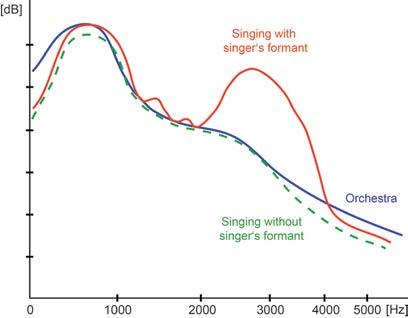
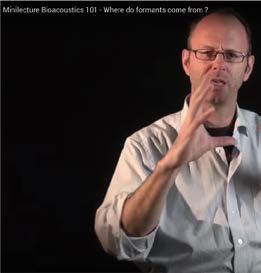

your ear to distinguish two voices.
The final piece of the puzzle in creating the perfect operatic sound is the opera house or theater itself. Designing the perfect acoustical space can be an almost impossible task, one which requires tremendous knowledge of science, engineering, and architecture, as well as an artistic sensibility. The goal of the acoustician is to make sure that everyone in the audience can clearly understand the music being produced onstage, no matter where they are sitting. A perfectly designed opera house or concert hall (for non-amplified sound) functions almost like gigantic musical instrument.


Reverberation is one key aspect in making a singer’s words intelligible or an orchestra’s melodies clear. Imagine the sound your voice would make in the shower or a cave. The echo you hear is reverberation caused by the large, hard, smooth surfaces. Too much reverberation (bouncing sound waves) can make words difficult to understand. Resonant vowel sounds overlap as they bounce off hard surfaces and cover up quieter consonant sounds. In these environments, sound carries a long way but becomes unclear or, as it is sometimes called, wet, as if the sound were underwater. Acousticians can mitigate these effects by covering smooth surfaces with textured materials like fabric, perforated metal, or diffusers, which absorb and disperse sound. These tools, however, must be used carefully, as too much absorption can make a space dry – meaning the sound onstage will not carry at all and the performers may have trouble even hearing themselves as they
perform. Imagine singing into a pillow or under a blanket.
The shape of the room itself also contributes to the way the audience perceives the music. Most large performance spaces are shaped like a bell – small where the stage is and growing larger and more spread out in every dimension as one moves farther away. This shape helps to create a clear path for the sound to every seat. In designing concert halls or opera houses, big decisions must be made about the construction of the building based on acoustical needs. Even with the best planning, the perfect acoustic is not guaranteed, but professionals are constantly learning and adapting new scientific knowledge to enhance the audience’s experience.
You will see a full dress rehearsal – an insider’s look into the final moments of preparation before an opera premieres. The singers will be in full costume and makeup, the opera will be fully staged, and an orchestra will accompany the singers, who may choose to “mark,” or not sing in full voice, to save their voices for the performances. A final dress rehearsal is often a complete run-through, but there is a chance the director or conductor will ask to repeat a scene or section of music. This is the last opportunity the performers have to rehearse with the orchestra before opening night, and they therefore need this valuable time to work. The following will help you better enjoy your experience of a night at the opera:
• Arrive on time! Latecomers will be seated only at suitable breaks in the performance and often not until intermission.
• Dress in what you are comfortable in so you can enjoy the performance. For some, that may mean dressing up in a suit or gown; for others, jeans and a t-shirt is fine. Generally, “dressycasual” is what people wear. Live theatre is usually a little more formal than a movie theater.
• At the very beginning of the opera, the concertmaster of the orchestra will ask the oboist to play the note “A.” You will hear all the other musicians in the orchestra tune their instruments to match the oboe’s “A.”
• After all the instruments are tuned, the conductor will arrive. You can applaud to welcome them!
• Feel free to applaud or shout Bravo at the end of an aria or chorus piece if you really liked it. The end of a piece can usually be identified by a pause in the music. Singers love an appreciative audience!
• It’s OK to laugh when something is funny or gasp at something shocking!
• When translating songs, and poetry in particular, much can be lost due to a change in rhythm, inflection, and rhyme of words. For this reason, opera is usually performed in its original language. In order to help audiences enjoy the music and follow every twist and turn of the plot, English supertitles are projected. Even when the opera is in English, there are still supertitles.
• Listen for subtleties in the music. The tempo, volume, and complexity of the music and singing depict the feelings or actions of the characters. Also, pay attention to repeated words or phrases; they are usually significant.
The singers, orchestra, dancers, and stage crew are all hard at work to create an amazing performance for you! Here’s how you can help them.
• Lit screens are very distracting to the singers, so please keep your phone off and out of sight until the house lights come up.
• Due to how distracting electronics can be for performers, taking photos or making audio or video recordings is strictly forbidden.
The theater is a shared space, so please be courteous to your neighbors!
• Please do not take off your shoes or put your feet on the seat in front of you.
• Respect your fellow opera lovers by not leaning forward in your seat so as to block the person’s view behind you.
• Do not chew gum, eat, or drink while the rehearsal is in session. Not only can it pull focus from the performance, but the ushers are not there to clean up after you.
• If you must visit the restroom during the performance, please exit quickly and quietly.
Otherwise, sit back, relax, and let the action onstage pull you in. As an audience member, you are essential to the art form of opera — without you, there is no show!
Have Fun and Enjoy the Opera!